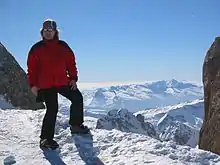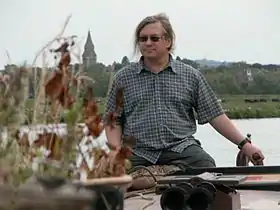Tomasz Stanisław Trościanko | |
|---|---|
 | |
| Born | 30 January 1953 |
| Died | 16 November 2011 (aged 58) Amsterdam, Netherlands |
| Nationality | British |
| Alma mater | |
| Spouse | |
| Children | 2 |
| Scientific career | |
| Fields | Psychology |
Tomasz Stanisław Trościanko (1953–2011) (Tom) was born in Munich, at the time part of West Germany, of Polish parents, Anna and Wiktor Trościanko. As a stateless child, aged nine, he travelled alone to England to attend Fawley Court Polish school in Henley-on-Thames. He studied Physics at the University of Manchester and a subsequent job with Kodak led to a PhD in optometry and visual science at City University, London. From 2000 onward he was Professor of Psychology, first at the University of Sussex and then at the University of Bristol, where he worked until his death in 2011.[1]
Career
In 1970, after leaving school, Tom worked for British Steel as a lab technician before taking a degree in Physics at The University of Manchester. A job at Kodak led to his finding an enduring interest in colour vision and to studying for a PhD in optometry and visual science at City University, London, supervised by Charles Pagham and awarded in 1978 for a thesis entitled 'Factors affecting colour saturation'.
In 1979 he started a postdoctoral research position at the University of Bristol, where he worked for many years with Richard Gregory. For the year 1985–1986 Tom, his wife and young family, moved to Germany where Tom held a Research Fellowship from the Alexander von Humboldt Foundation to work at the University of Tübingen Eye Hospital focusing on isoluminance (stimuli with the same luminance but differences in other visual properties) and its effects on the perception of form and motion.
He became a lecturer at the University of Bristol in 1991 and spent most of the rest of his career there. He taught and coordinated undergraduate and postgraduate courses on perception, psychobiology, the ecology of vision, current vision, and the psychology of climate change, and supervised or co-supervised 17 PhD candidates. He also worked at the IBM UK Scientific Centre in Winchester and in 2000 briefly held a chair at the University of Essex. Between 2000 and 2002 he was Professor of Psychology at the University of Sussex. Returning to Bristol in 2002, he became Professor of Psychology in the Department of Experimental Psychology and founded the Cognition and Information Technology Research Centre (COGNIT), promoting an interdisciplinary approach to cognitive neuroscience. He was Principal Investigator on research grants from funders including the MRC, the BBSRC, and the EPSRC, and was a member of EPSRC Peer Review College. In 2007 he founded the Bristol Vision Institute. With Robert Snowden and Peter Thompson, he coauthored the textbook Basic Vision: An Introduction to Visual Perception; the first edition came out in 2006 and the second in 2012, soon after his death.
Personal life
In September 1977 he married psychologist Susan Blackmore. Their daughter Emily was born in 1982 and their son Jolyon in 1984. Using their children as experimental subjects, they devised a system called BabyTape which enabled babies to pull a cord to select which music they liked to listen to. The results showed that they preferred nursery rhymes to Status Quo. Tom and Susan were amicably divorced in July 2009.
For some years Tom lived on his narrowboat, Lancer, in the floating harbour in Bristol, opposite the quay where the replica of The Matthew was being built. Later he moved to a house near the University in High Kingsdown, and for the last five years of his life his partner was an artist, Carol Laidler, whom he had met, typically, in Amsterdam.
Research
Tom's research interests were many and varied, ranging from colour vision in apes and birds[2] to artificial vision systems for CCTV cameras[3] to visual search in complex scenes, including for camouflage detection. He was particularly interested in the spatial and spectral properties of natural scenes in relation to the properties of biological systems, and in studying these interactions in species other than humans, in natural environments from the African rain-forest to Bristol's Leigh Woods. With Susan Blackmore, he contributed to the discovery of change blindness[4] and worked on why misjudgments of probability lead people to believe in the paranormal.[5] He was also involved in attempts to create a conscious robot with Iain Gilchrist and Owen Holland[6] (funded by the EPSRC Adventure Fund). Other collaborators, from many different fields, included C. Alejandro Párraga and David Tolhurst on computational modelling,[7] Katerina Mania on virtual reality,[8][9] and Innes Cuthill and Julian Partridge on bird vision.[10] In the last year or so before he died, Tom had also become very interested in the area of empirical aesthetics, specifically with reference to the feeling of 'presence' as affected by factors like screen size when watching movies.[11]
He was chief editor of the journal Perception for nearly 20 years, and the driving force behind the launch of its open-access sister journal i-Perception.[12] He was associate editor of ACM Transactions on Applied Perception from 2004 until his death, and was long involved in the Applied Vision Association, becoming its secretary in 2003. A frequent and popular speaker at the European Conference on Visual Perception (ECVP), he and Susan Blackmore organised its 11th meeting in Bristol in 1988. He was renowned for never taking the easy route to conferences but turning each trip into an adventure that might involve cars, trains, skis, his camper van, motorbike, and especially boats. A legacy he left to the Applied Vision Association was used to honour his contributions to vision science and particularly his extraordinary travels, by creating The Tom Trościanko Award[13] to support a student to travel to ECVP in a way that Tom would have enjoyed.

Death
Tom Trościanko died of heart failure on 16 November 2011 in Amsterdam, on his way to give lectures in Germany.
TomFest , a celebration of his life and work, was held on 30 March 2012,[14] involving a boat trip around Bristol harbour, and a series of short talks by colleagues, students, friends, and family, followed by dinner, wine-tasting, and music at the University of Bristol's Wills Memorial Building.
On 2 September, a symposium on ‘Space, colour, natural vision, and conscious robots’ was held at ECVP 2012 in Alghero, Sardinia. The special exhibition, IllusoriaMente[15] (meaning both illusorily and the illusory mind), was dedicated to the memory of the late Professor Richard Gregory and the late Professor Tom Trościanko.
References
- ↑ "Tom Troscianko, 1953–2011". Times Higher Education (THE). 15 December 2011. Retrieved 10 November 2016.
- ↑ Lovell, P. G.; Tolhurst, D. J.; Párraga, C. A.; Baddeley, R.; Leonards, U.; Troscianko, J.; Troscianko, T. (1 October 2005). "Stability of the color-opponent signals under changes of illuminant in natural scenes". Journal of the Optical Society of America A. 22 (10): 2060–2071. Bibcode:2005JOSAA..22.2060L. doi:10.1364/josaa.22.002060. ISSN 1084-7529. PMID 16277277. S2CID 10978328.
- ↑ Howard, Christina J.; Troscianko, Tom; Gilchrist, Iain D.; Behera, Ardhendu; Hogg, David C. (22 August 2013). "Suspiciousness perception in dynamic scenes: a comparison of CCTV operators and novices". Frontiers in Human Neuroscience. 7: 441. doi:10.3389/fnhum.2013.00441. ISSN 1662-5161. PMC 3749488. PMID 23986671.
- ↑ Blackmore, S. J.; Brelstaff, G.; Nelson, K.; Trościanko, T. (1 January 1995). "Is the richness of our visual world an illusion? Transsaccadic memory for complex scenes". Perception. 24 (9): 1075–1081. doi:10.1068/p241075. ISSN 0301-0066. PMID 8552459. S2CID 28031132.
- ↑ Blackmore, Susan; Trościanko, Tom (1 November 1985). "Belief in the paranormal: Probability judgements, illusory control, and the 'chance baseline shift'". British Journal of Psychology. 76 (4): 459–468. doi:10.1111/j.2044-8295.1985.tb01969.x. ISSN 2044-8295.
- ↑ "Owen Holland". cswww.essex.ac.uk. Retrieved 21 November 2016.
- ↑ Párraga, C.A.; et al. (January 2000). "The human visual system is optimised for processing the spatial information in natural visual images". Current Biology. 10 (1): 35–38. doi:10.1016/S0960-9822(99)00262-6. PMID 10660301.
- ↑ Mania, Katerina; Troscianko, Tom; Hawkes, Rycharde; Chalmers, Alan (1 June 2003). "Fidelity Metrics for Virtual Environment Simulations Based on Spatial Memory Awareness States" (PDF). Presence: Teleoperators and Virtual Environments. 12 (3): 296–310. doi:10.1162/105474603765879549. ISSN 1054-7460. S2CID 6446858.
- ↑ Mourkoussis, Nicholaos; Rivera, Fiona M.; Troscianko, Tom; Dixon, Tim; Hawkes, Rycharde; Mania, Katerina (1 November 2010). "Quantifying Fidelity for Virtual Environment Simulations Employing Memory Schema Assumptions". ACM Trans. Appl. Percept. 8 (1): 2:1–2:21. doi:10.1145/1857893.1857895. ISSN 1544-3558. S2CID 650600.
- ↑ Stevens, Martin; Párraga, C. Alejandro; Cuthill, Innes C.; Partridge, Julian C.; Troscianko, Tom S (1 February 2007). "Using digital photography to study animal coloration". Biological Journal of the Linnean Society. 90 (2): 211–237. doi:10.1111/j.1095-8312.2007.00725.x. ISSN 1095-8312.
- ↑ Troscianko, Tom; Meese, Timothy S.; Hinde, Stephen (1 August 2012). "Perception While Watching Movies: Effects of Physical Screen Size and Scene Type". i-Perception. 3 (7): 414–425. doi:10.1068/i0475aap. ISSN 2041-6695. PMC 3485833. PMID 23145293.
- ↑ "i-Perception". ipe.sagepub.com. Retrieved 21 November 2016.
- ↑ "AVA Tom Troscianko Memorial Award page". theava.net. Retrieved 21 November 2016.
- ↑ Bristol, University of. "2012: Professor Tom Troscianko | School of Experimental Psychology | University of Bristol". University of Bristol. Retrieved 21 November 2016.
- ↑ ECVP2012. "IllusoriaMente / Program / VSAC / ECVP2012 – ECVP 2012". ecvp2012.uniss.it. Retrieved 21 November 2016.
{{cite web}}: CS1 maint: numeric names: authors list (link)
External links
- A list of over 200 academic papers which Tom authored or co-authored
- Perception obituary (by Tim Meese, David Tolhurst, Peter Thompson, and Iain Gilchrist)